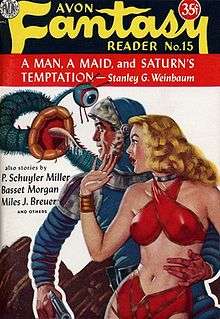Bug-eyed monster
The bug-eyed monster is an early convention of the science fiction genre.[1] Extraterrestrials in science fiction of the 1930s were often described (or pictured on covers of pulp magazines) as grotesque creatures with huge, oversized or compound eyes and a lust for women, blood or general destruction.

BEM, cover, Avon Fantasy Reader, 1951
In the contactee/abductee mythology, which grew up quickly beginning in 1952, the blond, blue-eyed, and friendly Nordic aliens of the 1950s were quickly replaced by small, unfriendly bug-eyed creatures, closely matching in many respects the pulp cover clichés of the 1930s which have remained the abductor norm since the 1960s.
Popular culture
- The Daleks from Doctor Who. When the show was created, the BBC producers stated that Doctor Who would be a "hard" science fiction show, and there would be no bug-eyed monsters – explicitly stated by show creator Sydney Newman. Writer Terry Nation created the Daleks in the show's second serial, much to Newman's disapproval, but later to his placation. These have frequently been referred to as bug-eyed monsters since that time.[2]
- The main character in the animated children's television series Invader Zim is a bug-eyed monster.
- The Pokémon species "Beheeyem" is based on the concept of bug-eyed monsters in its design, characteristics, and name.
- The aliens in the 1957 film Invasion of the Saucer Men are bug-eyed monsters and may have been the inspiration for the concept.
gollark: I know what you mean. I just don't care.
gollark: It's GPT-J, not GPT3-J.
gollark: How did you even make it run?
gollark: PotatOS isn't supported on OpenComputers.
gollark: Looks like HuggingFace something or other.
See also
References
- Urbanski, Heather (2007). Plagues, Apocalypses and Bug-Eyed Monsters: How Speculative Fiction Shows Us Our Nightmares. McFarland. pp. 149–168 and passim. ISBN 978-0-7864-2916-5.
- BBC – Doctor Who – A Brief History of the Daleks URL accessed April 26, 2007
This article is issued from Wikipedia. The text is licensed under Creative Commons - Attribution - Sharealike. Additional terms may apply for the media files.
